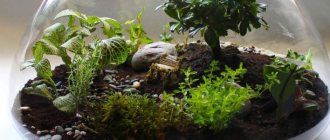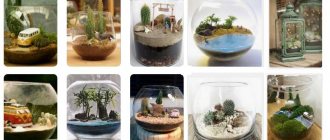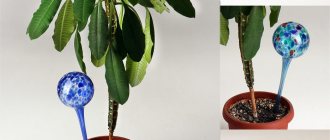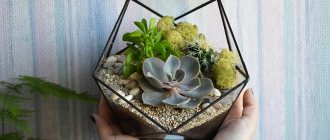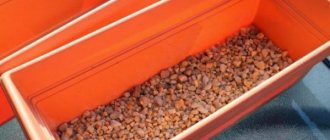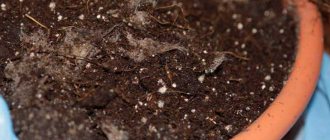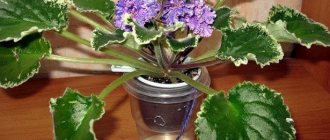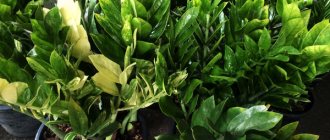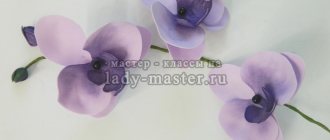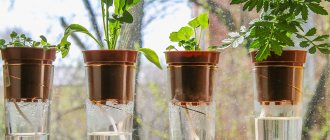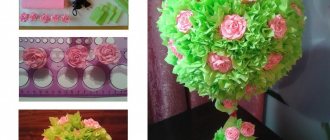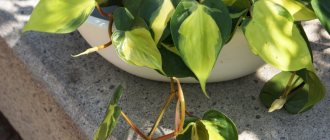In the modern world, every person strives to make the interior of a house or apartment special, adding an original twist. That is why the florarium (plant terrarium) is very popular. It's easy to do it yourself.
This process is creative and requires some skills, patience, financial costs and time. But such decor, made with your own hands, will give real aesthetic pleasure. Regardless of the time of year, you will always have a small home greenhouse that does not require much maintenance. We offer some tips on how to make a florarium with your own hands for beginners.
How to choose plants for a florarium
The choice of plants for a florarium depends entirely on your preferences, imagination and plans. First, decide on the ecosystem you want to create. Desert, tropics or mountain slopes - what kind of landscape do you want to reproduce?
Once a landscape has been selected, learn all about the soil that is typical for that type of terrain. Make sure that you can fully ensure the quality characteristics of the soil. And only after that start landscaping.
Plants for tropical florariums
The tropics are perhaps the most complex type of eco-environment. It is necessary to constantly provide a high level of humidity along with the supply of light for at least 12 hours. In addition, the presence or absence of air flow plays a big role. A large-scale tropical landscape can only be maintained with the installation of a climate control system. But miniature gardens will also require constant attention.
The most spectacular inhabitants of indoor tropics:
- indoor fern,
- crotons,
- moss,
- Fittonia.
Florarium-desert
Phytodesigners recommend starting with mini-greenhouses, which contain the most unpretentious plants. When we talk about the simplest florarium, of course we are talking about desert inhabitants.
Pay attention to the quality: it must be pure coarse sea sand. Small stones, roots, and shells of different sizes will add color.
Which desert representatives are suitable for modeling a mini-landscape:
- cactus,
- aloe,
- agave,
- echeveria,
- Haworthia.
Forest miniature
Forest miniatures are second only to the tropics in terms of complexity of execution and microclimate maintenance. The main problem is the root system of the forest flora, which requires a large amount of soil with a rather complex composition. It is simply impossible to maintain all proportions perfectly.
In addition, the forest is different from the forest: the bushes of the middle zone are unlikely to get along with moss from Siberia. Even the peat must correspond to the overall design.
But all of the above does not mean that we should abandon this luxurious idea:
- Use special fertilizers for feeding and neutral soil.
- Disinfect the soil with phytosporin and activated carbon more often.
- Replace rotten wood parts of the structure in a timely manner.
- Ventilate the indoor mini-forest regularly.
Basic principles of care
A DIY florarium is an excellent habitat for tropical plants and succulents. However, without proper care, the composition will lose its attractiveness. In addition, dust accumulates on glass containers, which should be removed regularly. Do the procedure very carefully, using a damp cloth.
You cannot leave streaks on the glass, otherwise the florarium will take on an untidy appearance.
Watering
The composition is moistened as the soil surface dries. After all, excess liquid often leads to rotting of the root system of plants. Florists advise paying attention to the inner surface of the walls of the glass vessel. If there is no condensation, then the garden needs watering.
Planned pruning
Since the plants are in a limited space, they need regular pruning. The procedure is performed using sharp scissors. Herbaceous crops are pinched by hand. To prevent fungal diseases, remove yellowed foliage.
Top dressing
Do-it-yourself fertilizers are applied to the soil in the florarium if colorless or pale yellow leaves appear on the crops. Do this carefully and in small doses. Otherwise, the plants may die.
Accommodation
The best place for a mini-garden behind glass is a window sill on the north or west side of the house. Direct sunlight causes the temperature inside the vessel to rise. As a result, vital plant processes are disrupted. Only succulents love an abundance of light.
Crops that bloom periodically are best placed where bright light is diffused. For example, in the middle of the room. In dark rooms, you can turn on additional electric lighting.
An original vase with cacti fits wonderfully next to the computer. And if you want to add charm to your bookshelves, you should decorate them with a home greenhouse. Hanging compositions will find their place on vertical walls.
Creating a mini-garden behind glass is a great opportunity to discover new talents. In addition, it is very interesting to watch the development of miniature plants. A florarium will enliven the living room, decorate the window sill, and add coziness to the bedroom. It is presented as an original gift. Using the video provided, you can safely get down to business.
Florarium with mountain landscape
Mountains are a favorite theme of phytodesigners. What could be more picturesque than cliffs with green spaces? The large list of plants that can be used to create an imitation is also attractive:
- dwarf ivy,
- indoor fern,
- saxifrage,
- asparagus and others.
The requirements are the same:
- Achieve complete compatibility between soil and plants.
- The level of humidity, lighting, temperature must fully correspond to the type of landscape.
- Plant only low-growing varieties.
- A vase for a florarium should have a wide neck - this is necessary for good air circulation.
Florarium with flowers
Floral arrangements can be either temporary (with water) or long-term projects - it all depends on the qualities and properties of the flower.
- Orchids. Installations with this capricious but beautiful inhabitant of the subtropics are placed in a separate group. Prestigious orchidariums require painstaking work and tireless care to ensure a comfortable microclimate.
- Cyclamens. The butterfly flower is grown either alone or in combination with alocasia or fern. Achieving ideal conditions in a glass container for the delicate creature that cyclamen has always been is quite difficult. But it is even more difficult to maintain these conditions in proper condition.
- Anthurium is like no other suitable for a mini-greenhouse. Bright flowers fill the entire space, creating a magnificent three-dimensional picture. Naturally, we are talking about dwarf hybrids. However, ordinary varieties also perform well in the long term.
- Violets are good both in closed mini florariums and in open ones. If the flower is provided with comfortable conditions and care, it will delight you with its flowering for a long time.
Soil for a mini garden
Since the florarium consists of various crops, the soil is chosen taking into account their needs. For beginner fans of greens, ready-made mixtures that are sold in specialized retail outlets are suitable. Experienced craftsmen make universal soil on their own from peat substrate and sand (1:1). If cacti or succulents are planted, the soil is prepared in a 1:2 ratio.
Typically, glass tanks intended for florariums are produced without holes. Therefore, the garden needs artificial drainage. It is made from pebbles, moss and charcoal. The components are laid out step by step on the bottom of the container. If you plan to use undemanding crops, disinfected soil from a forest or garden bed is suitable.
To create complex compositions, plants are planted in separate containers with different soils and wrapped in moss.
Instructions for creating a florarium
We offer a master class using the example of succulents. We will plant echeveria, crassula and haworthia - the most unpretentious creatures. The installation is suitable not only for home decor, but also for decorating an office space.
Step-by-step instructions for creating a florarium:
- Carefully remove the roots of the purchased succulents from the shipping container and soil. To do this, lightly rub the flower pot between your palms and shake off the soil.
- Making a florarium begins with preparing the container. The container can be anything: glass, ceramic, even metal or wood. The main thing is that the bottom is covered with biomica or covering material - this will protect against rust or rotting.
- We form a drainage layer. Volcanic zeolite, a material with the most universal properties, can be used as drainage.
- We arrange the succulents in the intended order, leaving room for decorative elements. When planting, take into account the factor of subsequent growth of the seedling.
- We fill the roots with a specialized soil mixture. The ideal solution is ready-made soil purchased at a flower shop.
- Lightly trample the root space and spill it with water at room temperature. Try to avoid overwatering: no more than a tablespoon of water for each root. Any more will cause rotting. The larger the shape of the container, the greater the moisture, but not more than 20 milliliters.
- We decorate with decor: driftwood, natural or artificial moss, pebbles, multi-colored crystals.
Remember that succulents love light. Choose a location with sufficient lighting. The frequency of watering is determined by the level of humidity in the room, but not more than once every two weeks.
Newbie tryouts
A tall jar is the optimal container for beginning florarium designers. The registration process will require the following materials:
- jar with a capacity of 3 liters or more;
- charcoal;
- 1 part of peat is taken as soil for 2 parts of leaf soil;
- dustpan, watering can and gloves;
- moss and suitable plants, in our case these are cryptanthus, impatiens, asplenium.
The composition guide contains the following points:
- The bottom of the florarium is covered with a 5-centimeter layer of charcoal. The remaining material is mixed with the prepared soil.
- The resulting mixture is added to the vessel in stages, every 5 cm the soil is compacted to avoid the formation of air gaps.
- Having filled half the volume of the florarium with soil, they proceed to planting plants. When decorating, it is important to maintain a gap of 3-4 cm so that the bushes of the composition do not create obstacles to each other.
- After checking the quality of deepening of plant roots and compacting the soil, they proceed to decorating the free surface with moss.
- The planted plants are carefully watered from a watering can with a thin spout, avoiding moisture getting on the leaves of the composition. Failure to comply with this condition will lead to rotting processes in the florarium, the development of mold and mildew.
The resulting composition is located in an area with diffused lighting; this will limit the growth of plants due to the lack of direct rays of the sun. Watering an open-type florarium is done approximately once a week, it all depends on the plants chosen for decoration. In case of excessive growth, excess leaves are trimmed.
Florariums with bonsai tree
A landscape with bonsai is one of the most stylish and prestigious installations, something akin to art. The cost of individual copies, especially wall works, reaches 250 €.
The most spectacular idea is a tree in a closed geometric florarium. However, phytomasters believe: the microcosm formed in a sealed vessel is so vulnerable that a decrease in temperature of just 2-3 degrees will be disastrous for roots and leaves.
What is the product?
A plant terrarium is a miniature tropical garden with plants in a glass container.
A special microclimate is created inside it, which is necessary for the normal development of flowers. Basic care is carried out through a special hole.
Such devices for growing plants date back to the 18th century. Then flowers were brought from southern countries and, in order to bring them safe and sound, to help adapt to a different climate, they were transplanted into pots, which were covered with a glass lid on top.
In such conditions, absolutely diverse plants are grown; this small container can be compared to a home botanical garden, it’s so beautiful there. The size of the container may vary. These are mostly small bottles and spheres. You can also make a small geometric florarium. Sometimes even huge vessels are used.
This decor is quite popular due to its durability. With proper care, plants in a terrarium can live for more than ten years.
Master class: do-it-yourself florarium for plants. Video:
Master class: DIY Florarium for Plants. Stained glass using Tiffany technique
